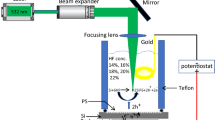Abstract
The physical mechanism of highly efficient photoluminescence (PL) emission from p-type silicon is described by a comparative study of the effectiveness of the etching parameters in an electrochemical anodization technique. Two series of porous silicon samples were prepared in a combination of anodization current and time, to maintain the total amount of anodic charge transfer constant. Photoluminescence studies show that irrespective of the amount of charge transfer, the samples prepared with comparatively higher current density show an efficient PL as well as stronger blueshift in the emission energy vis-à-vis the samples prepared for longer durations. An overall decrease in crystallite size, as estimated by Raman spectral analysis, was observed for both series of samples with the progress of charge transfer. Comparative analysis shows a marginal difference in crystallite size for both series of samples in the initial state of charge transfer, whereas major differences arise at higher values. This is explained with the formation of silicon suboxide on the porous surface at higher current density, leading to initiation of side wall reaction, and higher reduction rate in crystallite size as well as strong luminescence due to the carrier quantum confinement effect.
Similar content being viewed by others
References
Canham LT (1990). Appl Phys Lett 57:1046–1048
Lehman V (2002) Electrochemistry of Silicon. Wiley VCH, New York, p 277
Foll H, Christophersen M, Carstensen J, Hasse G (2002). Mater Sci Eng R 39:93–141
Astrova EV, Borovinskaya TN, Tkachenko AV, Balakrishnan S, Perova TS, Afferty A, Gun’ko YK (2004). J of Micromechanics and Microengg 14:1022–1028
Turton R (2000) The Physics of Solids. Oxford University Press, New York
Gelloz B, Kojima A, Koshida N (2005). Appl Phys Lett 87:031107. (3 pages)
Váaquez-A MA, Águila Rodríguez G, García-Salgado G, Romero-Paredes G, Peňa-Sierra R (2007). Revista Mexicana De Física 53:431–435
Benyahia B, Gabouze N, Haddadi M, Guerbous L, Beldjilali K (2008). Thin Solid Films 516:8707–8711
Sharma SN, Banerjee R, Das D, Chattopadhyay S, Barua AK (2001). Appl Surf Sci 182:333–337
Ziong ZH, Liao LS, Yuan S, Yang ZR, Ding XM, Hou XY (2001). Thin Solid Films 388:271–276
Zhang YH, Li XJ, Zheng L, Chen QW (1998). Phys Rev Lett 81:1710–1713
Naddaf M, Hamadeh H (2009). Mater Sci Eng C 29:2092–2098
Zhao Y, Yang D, Li D, Jiang M (2005). Mater Sci Eng B 116:95–98
Fujiwara M, Matsumoto T, Kobayashi H, Tanaka K, Happo N, Horii K (2005). J Lumin 113:243–248
Kolasinski KW, et al. (2000). J Appl Phys 88:2472–79
Guha S, Steiner P, Lang W (1996). J Appl Phys 79:8664–68
Islam MN, Kumar S (2001). Appl Phys Lett 78:715–17
Kanemitsu Y, Uto H, Masumoto Y, Matsumoto T, Futagi T, Mimura H (1993). Phys Rev B 48:2827
Richter H, Wang ZP, Ley L (1986). Solid State Commun 39:625–629
Campbell IH, Fauchet PM (1986). Solid State Commun 58:739–741
Bisi O, Ossicini S, Pavesi L (2000). Surf Sci Rep 38:1–126
Smith RL, Collins SD (1929). J Appl Phys 71:R1–R22
Peter LM, Riley DJ, Wielgosz R (1995). Appl Phys Lett 66:2355–2357
Lévy-Clément C, Lagoubi A, Tomkievicz M (1994). J Electrochem Soc 141:958–967
Lehmann V, Föll H (1990). J Electrochem Soc 137:653–659
Koyama H (2006). J Appl Electrochem 36:999–1003
Bertolotti M, Carassiti F, Fazio E, Ferrari A, La Monica S, Lazarouk S, Liakhou G, Maiello G, Proverbio E, Schirone L (1995). Thin Solid Films 255:152–154
Propst EK, Rieger MM, Vogt KW, Kohl PA (1994). Appl Phys Lett 64:1914–1916
Acknowledgments
The author 1 gratefully acknowledges the financial support provided by Department of Science & Technology, Govt. of India, through its INSPIRE Grant No. IFA-12 ENG-13.
Author information
Authors and Affiliations
Corresponding author
Rights and permissions
About this article
Cite this article
Dhanekar, S., Islam, S.S. Efficient PL Emission from p-type Porous Silicon: A Comparative Study for Selection of Effective Anodization Parameters. Silicon 10, 725–730 (2018). https://doi.org/10.1007/s12633-016-9522-9
Received:
Accepted:
Published:
Issue Date:
DOI: https://doi.org/10.1007/s12633-016-9522-9




